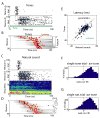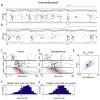Spontaneous events outline the realm of possible sensory responses in neocortical populations
- PMID: 19447096
- PMCID: PMC2696272
- DOI: 10.1016/j.neuron.2009.03.014
Spontaneous events outline the realm of possible sensory responses in neocortical populations
Abstract
Neocortical assemblies produce complex activity patterns both in response to sensory stimuli and spontaneously without sensory input. To investigate the structure of these patterns, we recorded from populations of 40-100 neurons in auditory and somatosensory cortices of anesthetized and awake rats using silicon microelectrodes. Population spike time patterns were broadly conserved across multiple sensory stimuli and spontaneous events. Although individual neurons showed timing variations between stimuli, these were not sufficient to disturb a generally conserved sequential organization observed at the population level, lasting for approximately 100 ms with spiking reliability decaying progressively after event onset. Preserved constraints were also seen in population firing rate vectors, with vectors evoked by individual stimuli occupying subspaces of a larger but still constrained space outlined by the set of spontaneous events. These results suggest that population spike patterns are drawn from a limited "vocabulary," sampled widely by spontaneous events but more narrowly by sensory responses.
Figures








References
-
- Abeles M. Corticonics: neural circuits of the cerebral cortex. Cambridge: Cambridge University Press; 1991.
-
- Agresti A. Categorical Data Analysis. Wiley; 2002.
-
- Armstrong-James M, Fox K, Das-Gupta A. Flow of Excitation Within Rat Barrel Cortex on Striking A Single Vibrissa. Journal of Neurophysiology. 1992;68:1345–1358. - PubMed
-
- Baker SN, Lemon RN. Precise spatiotemporal repeating patterns in monkey primary and supplementary motor areas occur at chance levels. J Neurophysiol. 2000;84:1770–1780. - PubMed
Publication types
MeSH terms
Grants and funding
LinkOut - more resources
Full Text Sources
Other Literature Sources

